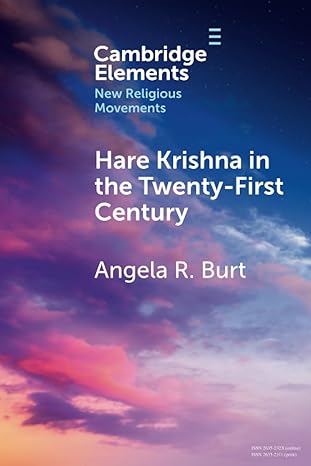Henry reviews Angela R. Burt’s book: Hare Krishna in the Twenty-First Century

Hare Krishna in the Twenty-First Century, cover.
5 Stars, Excellent Synopsis.
I first met (by email) Angela Burt in 2011, when she was a student at Leeds University in West Yorkshire, England. I heard she was writing her thesis about the zonal acharya era of ISKCON (International Society for Krishna Consciousness) and I wanted to know if she might share any information with me about one of the zonal acharyas, His Divine Grace Kirtanananda Swami Bhaktipada. I was a member of ISKCON, a disciple of Kirtanananda Swami, and a resident of the New Vrindaban Hare Krishna Community in Marshall County, West Virginia, for 15-16 years (1978-1994). Angela (known in Krishna circles as Arya Devi Dasi) is also a member of ISKCON having received initiation from His Divine Grace Ravindra Svarupa Dasa. At the time in 2011, I was conducting research for my proposed biography of Kirtanananda Swami and history of the New Vrindaban Community.
I heard Burt’s thesis, titled Leading the Hare Krishna Movement: The Crisis of Succession in the International Society for Krishna Consciousness, 1977-1987, was completed three years later in 2014. After waiting patiently for ten years, I was greatly pleased to finally discover, in 2024, that her thesis was published by Routledge New Religions, and I purchased a copy of Leading the Hare Krishna Movement: The Crisis of Succession in the International Society for Krishna Consciousness. At the same time, I discovered she had authored another book, Hare Krishna in the Twenty-First Century, so I purchased both books.
Regarding Hare Krishna in the Twenty-First Century, I was very pleased with her brief, but fairly comprehensive description of the history of ISKCON, including its origin in Bengal, India in the 16th-century, the introduction of the faith to the United States in 1965 by the missionary founder of ISKCON, Bhaktivedanta Swami Prabhupada, the expansion of ISKCON throughout the world, the beliefs and practices of its devotees, and even a description of a day in the life of an ISKCON temple resident.
Ms. Burt goes on to tell about developments in ISKCON after the passing of the Founder, including topics such as: legal disputes, internal disputes, child abuse in the ISKCON schools, the marginalization of women, and recent attempts to modify the presentation of Bhakti Yoga in an attempt to attract contemporary converts.
Of course, while discussing many topics, each is presented in brief, as is necessary in a book of only 90-some pages, but the synopsis is accurate and engaging to read. I congratulate Dr. Angela Burt for this excellent book.
Perhaps I might mention just a few minor errors, which I discovered while reading her book. After completing a ten-volume biography of Kirtanananda Swami Bhaktipada titled Gold, Guns and God: Swami Bhaktipada and the West Virginia Hare Krishnas, I have uncovered much about the life of the man who was once my spiritual master, and an ISKCON-approved guru. I wrote to Angela and shared these critical points, and suggested, as her book is a print-by-demand book, it should be a simple matter to correct these errors for future readers. In the interest of accuracy, I wish to point out, on p. 31, there are four minor errors.
1) Kirtanananda was convicted of racketeering in 1991. He was incarcerated first at the Eastern Regional Jail in Martinsburg, West Virginia, then under house arrest in Warwood, a suburb of Wheeling. In 1993 Bhaktipada won his appeal, his 1991 convictions were overturned, and he was released from house arrest.
2) Two members of New Vrindaban (not just one) were convicted in two separate cases regarding the murder of Steven Bryant: Tirtha (Thomas Drescher) the murderer and Tapahpunja (Terry Sheldon), an assistant. Sheldon was released after 5 years, but Tirtha remains in prison still, serving two life sentences.
3) In 1996 Bhaktipada was tried again, and pleaded guilty to one count of mail fraud. He was sentenced to 30 years in prison (some sources claim 20 years), but was released after 8 years due to poor health.
4) Bhaktipada was released from prison in 2004 and Bhaktipada died in 2011.
Hare Krishna.
Sincerely,
Henry Doktorski
Author of Killing For Krishna, Eleven Naked Emperors, and ten volumes of Gold, Guns and God.
Temecula, California
April 5, 2025To purchase Hare Krishna in the Twenty-First Century, go to Amazon.
To read Henry’s review on Amazon, go to Amazon.
Back to: Eleven Naked Emperors Homepage